White garden ideas transform ordinary outdoor spaces into ethereal retreats.
Imagine stepping into a luminous landscape where snowy blooms catch moonlight and silvery foliage whispers in evening breezes!
These gardens – timeless yet trendy – create a sense of serenity impossible to achieve with vibrant colors.
Whether you’re dreaming of romantic white roses climbing trellises or contemporary white architecture framing your space, these monochromatic masterpieces prove that sometimes, less truly becomes more.
Ready to embrace the white garden magic?
1. Achieve Impact with Mass Planting
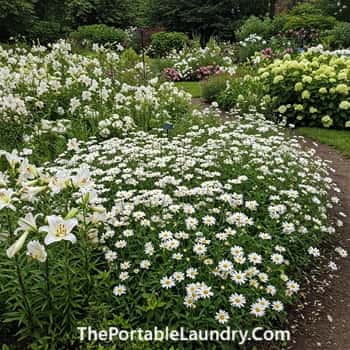
Create breathtaking sweeps of pure white by planting large drifts of a single type of flower. Consider a vast swathe of white ‘Iceberg’ roses delivering continuous bloom.
Or perhaps fill a significant area with the snowy simplicity of Shasta daisies. This technique offers unparalleled visual power.
2. Structure the Space with White Architecture
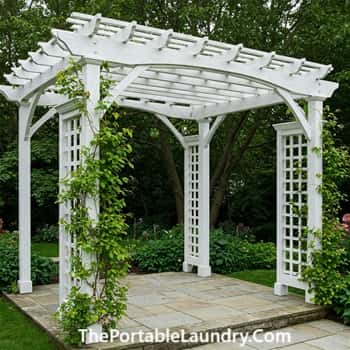
Utilize hardscaping elements painted brilliant white to define and enhance the garden’s luminous quality.
A white pergola draped in greenery offers vertical interest and a shaded spot.
Crisp white fences provide boundaries and a clean backdrop for plantings. These structures amplify the all-white theme.
3. Introduce Silvery Companions
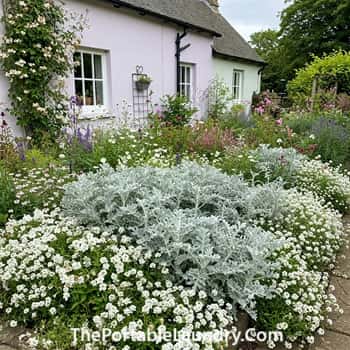
Weave plants with silver or grey foliage amongst your white blooms for subtle contrast and texture. Dusty Miller (Senecio cineraria) or silvery Artemisia provide a cool counterpoint.
Their lighter leaves catch the light beautifully, complementing the white flowers without competing. This expands the palette while staying ethereal.
4. Focus on Form and Texture Variations
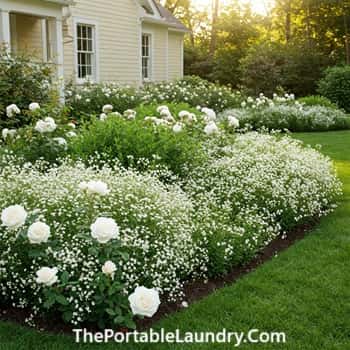
When color is limited, variations in form and texture become paramount.
Juxtapose the large, bold blooms of white peonies against the frothy, delicate sprays of Baby’s Breath (Gypsophila).
Contrast the smooth petals of a white tulip with the intricate structure of a white Astilbe plume.
The tactile and structural diversity keeps the monochromatic scheme fascinating.
5. Pave the Way with Pale Materials

Extend the white theme underfoot using light-colored materials for paths and patios.
White gravel crunches satisfyingly and brightens walkways immensely.
Pale sandstone or light grey concrete pavers create serene seating areas that reflect light upwards. These surfaces contribute significantly to the garden’s overall brightness.
6. Furnish with Elegant White Seating

Incorporate seating elements that adhere to the color scheme, providing places to rest and admire the view.
A classic white wrought-iron bench adds a touch of romance.
Perhaps position simple white Adirondack chairs for a more relaxed feel.
These pieces become part of the serene white composition.
7. Curate Collections of White Containers
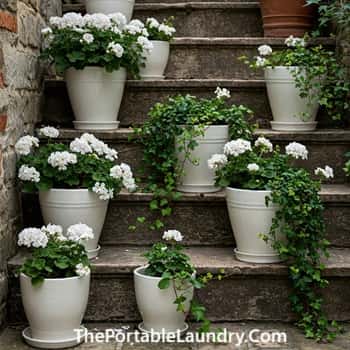
Group various white pots and planters together for concentrated points of interest.
Mix different sizes, shapes, and textures – glossy ceramic, matte terracotta painted white, classic urns.
Plant them with white flowers or contrasting green foliage for versatile accents on patios or steps. Container groupings offer stylistic punctuation.
8. Reach for the Sky with White Climbers
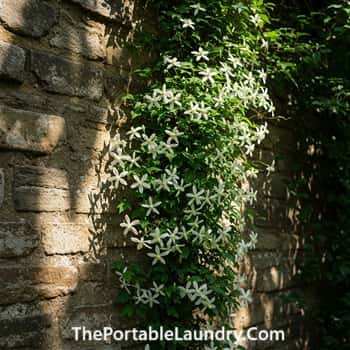
Train white-flowering vines to ascend walls, fences, or trellises, adding vertical dimension.
The abundant blooms of white climbing roses like ‘Madame Alfred Carrière’ are stunning.
Consider the elegant trumpet flowers of white Mandevilla or the starry profusion of white Clematis.
Vertical elements draw the eye upward beautifully.
9. Add Sparkle with White Garden Accents
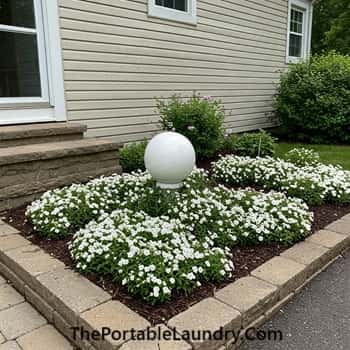
Introduce non-plant elements that enhance the theme through color and reflection.
A classic white birdbath attracts feathered visitors and mirrors the sky.
Strategically placed white statuary can act as focal points.
Even reflective gazing balls (in silver or white) add a touch of whimsy and light.
10. Reflective Qualities of Water Features
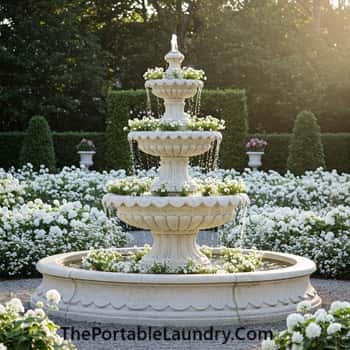
Incorporate water elements constructed from or featuring white materials.
A tiered fountain made of white stone creates soothing sounds and visual appeal.
A pond edged with white pebbles or coping reflects the surrounding white plantings and the sky above. Water doubles the impact of the light.
11. Strategic Lighting for Nocturnal Brilliance
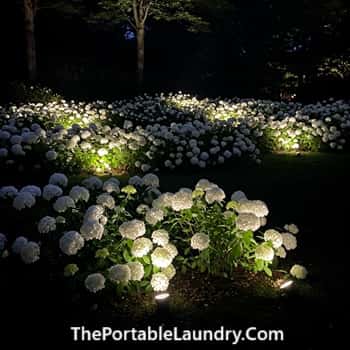
Install subtle landscape lighting specifically to enhance the white garden after dark.
Uplights positioned at the base of plants with white flowers or silvery foliage make them seem to radiate light.
Soft path lighting using white fixtures ensures safe passage while maintaining the ethereal mood.
Nighttime viewing becomes a key feature.
12. Layer Blooms for Continuous White
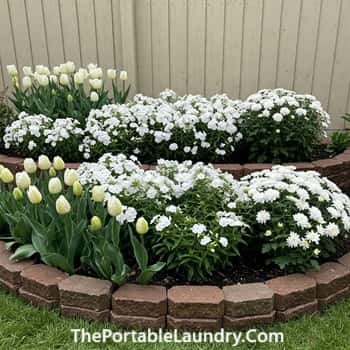
Plan your plantings to ensure a succession of white blooms throughout the growing season.
Start with spring bulbs like white crocuses and daffodils. Move into early summer with white irises and peonies, followed by hydrangeas and phlox.
Finish with autumn-blooming white chrysanthemums or anemones. This guarantees the white theme endures.
13. An Emphasis on White Fragrance
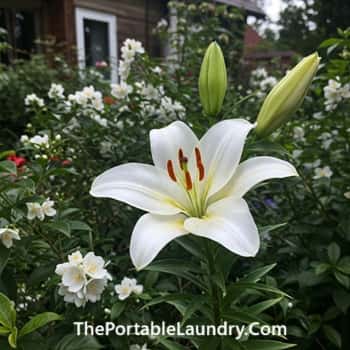
Make the white garden a feast for the nose as well as the eyes by selecting richly scented white flowers.
Place fragrant options like white Lilies, Gardenia, or Nicotiana near pathways or seating areas. The intoxicating perfume of white Hyacinths in spring is unforgettable.
Scent adds an invisible yet powerful dimension.
14. Define Borders with White Elements

Create crisp, clean edges for garden beds using white materials or plants.
A low border of smooth white river stones provides a neat separation from lawns or paths.
Alternatively, plant a miniature hedge of low-growing, white-flowering plants like Candytuft (Iberis sempervirens).
These defined edges give the garden a polished look.
Final Thoughts
Interestingly, white gardens aren’t merely aesthetic choices – they’re psychological sanctuaries.
Research shows that monochromatic white spaces reduce stress hormones by creating visual coherence that calms our overstimulated minds.
Plus, these gardens employ a fascinating optical phenomenon: as daylight fades, white flowers appear to float mysteriously while colored blooms disappear into darkness.
This “lunar effect” explains why white gardens were historically planted near bedroom windows to illuminate pathways before electric lighting.
Consider planting night-blooming white varieties like evening primrose or moonflower to enhance this magical quality.
Remember – successful white gardens require maintenance vigilance since browning foliage or spent blooms become more noticeable against pristine backgrounds.





